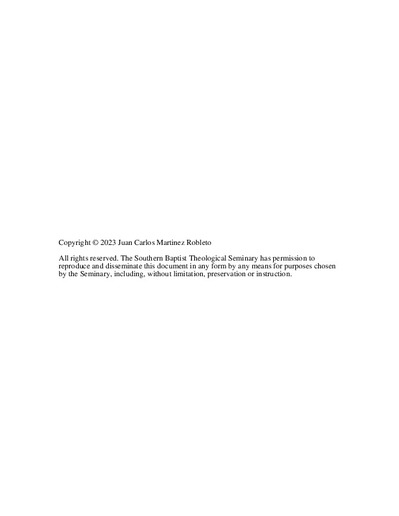| dc.contributor.advisor | Irving, Justin A. | |
| dc.contributor.author | Robleto, Juan Carlos Martinez | |
| dc.date.accessioned | 2023-06-02T19:25:24Z | |
| dc.date.available | 2023-06-02T19:25:24Z | |
| dc.date.issued | 2023-04-30 | |
| dc.identifier.uri | https://hdl.handle.net/10392/7111 | |
| dc.description.abstract | This dissertation was designed to identify best practices for leading organizational change in the local church ministering in an urban context. The dissertation also sought to determine whether the leadership in the local church could lead their congregations through successful organizational change and meaningful cultural engagement without forsaking biblical and theological orthodoxy.
The research validates most of the best practices identified in the literature review. However, it also encountered five distinct best practices common to all three participating sites that are unique to their local ministry contexts: (1) allowing doctrine and theology to inform practice, (2) discipleship, (3) preaching, (4) adaptation and flexibility, and (5) internal cultural change through transformational leadership.
Chapter 1 introduces the research problem and the purpose of the research study. Chapter 2 reviews the precedent literature related to organizational change. This chapter emphasizes the church’s role as an organizational system and discusses essential information on leadership. It also explores existing models for conducting organizational change, John Kotter’s 8-Step Model (8SM) and the Transformational Journey Model (TJM) recommended by Jim Herrington, Mike Bonem, and James Furr, and introduces Mark McCloskey’s 4R Model of Transformational Leadership as another model for consideration.
Chapter 3 provides a detailed explanation of the research methodology of the research study while explaining the case studies in detail and the content analysis approach for conducting empirical research. Chapter 4 provides a detailed analysis of the findings, examining each best practice identified by the research study and correlating its implications to the practice of leading organizational change in the local church.
Chapter 5 thoroughly examines McCloskey’s 4R Model and details its components and subcomponents. It interacts with the precedent literature in chapter 2 and the findings in chapter 4 to bridge the best practices and leadership traits observed in part 1 of the case study and those of the 4R Model. This chapter also documents a retrospective analysis of the best practices exhibited by the sites participating in part 1 of the study against the 4R Model. Chapter 6 offers concluding thoughts regarding the dissertation’s implications and applications for the local church based on its findings and provides possible considerations for future research. | en_US |
| dc.subject.lcsh | Christian leadership | en_US |
| dc.subject.lcsh | Organizational change--Case studies | en_US |
| dc.subject.lcsh | Organizational change--Management | en_US |
| dc.subject.lcsh | Change--Religious aspects--Christianity | en_US |
| dc.subject.lcsh | City churches | en_US |
| dc.title | Best Practices in Leading Organizational Change in the Local Church: A Multi-Case Study | en_US |
| dc.type | Electronic dissertation | en_US |
| dc.type | Text | |
| dc.contributor.committee | Irving, Justin A. | |
| dc.contributor.committee | Bosch, David A. | |
| dc.contributor.committee | Foster, Anthony W. | |
| dc.type.qualificationname | Ph.D. | en_US |
| dc.publisher.institution | Southern Baptist Theological Seminary | en_US |
| dc.publisher.department | School of Missions and Evangelism | |

